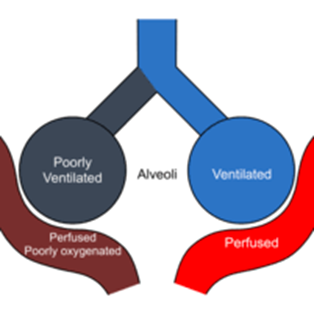A nurse is caring for a client who has respiratory failure due to ventilation-perfusion (V/Q) mismatch. The nurse should recognize that the client most likely has which of the following conditions?
Flail chest
Emphysema
Congestive heart failure
Guillain-Barré syndrome
None
None
The Correct Answer is B
Choice A Reason:
Flail chest is incorrect. Flail chest is a condition characterized by multiple rib fractures, causing instability in the chest wall. While it can lead to respiratory distress, it doesn't directly cause ventilation-perfusion (V/Q) mismatch. Instead, it impairs the mechanics of breathing by compromising chest wall integrity.
Choice B Reason:
Emphysema is a chronic obstructive pulmonary disease (COPD) where the alveolar walls are destroyed, leading to a loss of surface area for gas exchange. This results in areas of the lungs that are well-perfused but poorly ventilated, causing a V/Q mismatch. The damage to alveoli leads to impaired ventilation, while blood flow may still be adequate, leading to hypoxemia (low oxygen levels in the blood).
Choice C Reason:
CHF primarily affects the heart’s ability to pump blood effectively, leading to pulmonary congestion and impaired gas exchange. However, it typically causes diffusion defects rather than a direct ventilation-perfusion mismatch. V/Q mismatch may occur secondary to pulmonary edema, but it’s not the primary mechanism of respiratory failure in CHF.
Choice D Reason:
Guillain-Barré syndrome is incorrect. Guillain-Barré syndrome (GBS) is a neurological disorder that affects the peripheral nervous system, leading to muscle weakness and paralysis. While respiratory muscle weakness can occur in GBS, it doesn't directly cause ventilation-perfusion (V/Q) mismatch. GBS primarily affects nerve function rather than lung function.

Nursing Test Bank
Naxlex Comprehensive Predictor Exams
Related Questions
Correct Answer is D
Explanation
Choice A Reason:
Myelogram is not appropriate. This imaging test involves injecting contrast dye into the spinal canal to visualize the spinal cord and nerve roots. While it may help identify certain spinal cord abnormalities, it is not typically used as a primary diagnostic tool for multiple sclerosis.
Choice B Reason:
Brain natriuretic peptide (BNP) is not appropriate. This blood test measures the level of BNP, a hormone produced by the heart, which can be elevated in conditions such as heart failure. It is not used in the diagnosis of multiple sclerosis.
Choice C Reason:
Troponin level is not appropriate. Troponin is a protein released into the bloodstream during a heart attack or other heart-related conditions. This test is used to diagnose heart muscle damage and is not relevant to the diagnosis of multiple sclerosis.
Choice D Reason:
Lumbar puncture is appropriate. Also known as a spinal tap, a lumbar puncture involves collecting cerebrospinal fluid (CSF) from the spinal canal for analysis. In the diagnosis of multiple sclerosis, analysis of CSF can help identify certain abnormalities, such as an elevated level of immunoglobulin G (IgG) or the presence of oligoclonal bands, which are often indicative of inflammation in the central nervous system. Therefore, a lumbar puncture is commonly ordered to assist with the diagnosis of multiple sclerosis.
Correct Answer is B
Explanation
Choice A Reason:
Drooling is inappropriate. Drooling, also known as sialorrhea, is a common symptom in Parkinson's disease due to impaired swallowing and reduced control of the muscles involved in saliva production. Anticholinergic medications can exacerbate dry mouth, which may contribute to drooling. However, drooling is not typically a side effect that would be specifically associated with anticholinergic use.
Choice B Reason:
Anhidrosis is appropriate. Anhidrosis refers to the inability to sweat normally. Anticholinergic medications can inhibit sweating by blocking the action of acetylcholine on sweat glands, leading to decreased sweating and potentially causing hyperthermia. Anhidrosis is a potential side effect of anticholinergic agents and should be reported to the healthcare provider due to the risk of overheating.
Choice C Reason:
Tremors is inappropriate. Tremors are a common symptom of Parkinson's disease and are typically not caused by anticholinergic medications. In fact, anticholinergic agents are often prescribed to help reduce tremors in individuals with Parkinson's disease. Tremors would not be considered an adverse effect that the client should report in the context of anticholinergic therapy.
Choice D Reason:
Rigidity is inappropriate. Rigidity, or stiffness of the muscles, is a characteristic symptom of Parkinson's disease resulting from the loss of dopamine-producing neurons in the brain. While anticholinergic medications can help alleviate some symptoms of Parkinson's disease, they are not typically associated with rigidity. Rigidity would not be considered an adverse effect that the client should report in the context of anticholinergic therapy.

Whether you are a student looking to ace your exams or a practicing nurse seeking to enhance your expertise , our nursing education contents will empower you with the confidence and competence to make a difference in the lives of patients and become a respected leader in the healthcare field.
Visit Naxlex, invest in your future and unlock endless possibilities with our unparalleled nursing education contents today
Report Wrong Answer on the Current Question
Do you disagree with the answer? If yes, what is your expected answer? Explain.
Kindly be descriptive with the issue you are facing.
